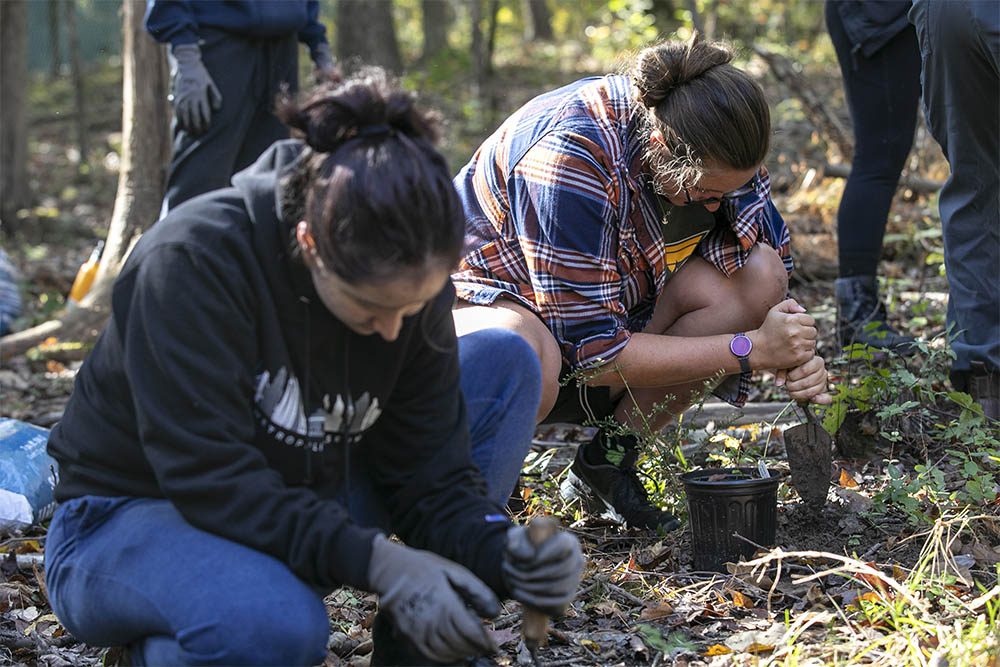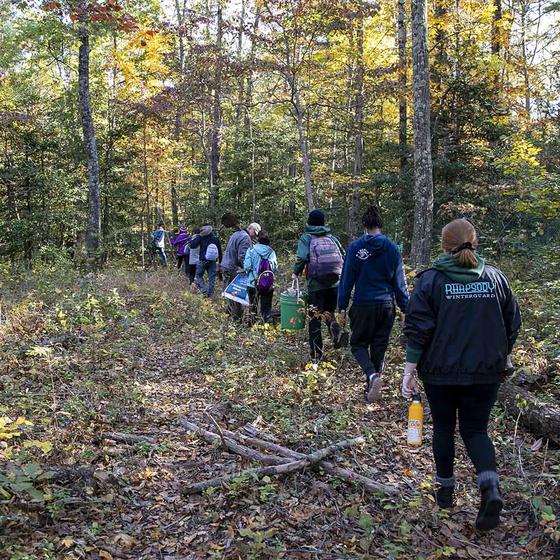An unlikely collaboration between George Mason University’s Honey Bee Initiative and the new outdoor Forensic Science Research and Training Laboratory could yield critical advances in forensic science.
Mason teams from a number of different fields are working in unison at the Science and Technology Campus in Manassas, Virginia, on an ambitious project to see if the honey produced by bees after feeding on flowers can help them better locate missing persons.

Photo by Shelby Burgess/Strategic Communications
Proteins in bee honey contain biochemical information about what the bees have fed upon. That information has previously been used to detect the chemical signature of pesticides in honey, allowing observers to deduce what specific types of pesticides were being used within the five-mile radius from the hives that honey bees typically frequent.
Similarly, O’Toole and her team believe that volatile organic compounds (VOCs) of human decomposition might likewise be found in bee honey, allowing authorities to then triangulate where missing human remains might be located. That ability could ultimately help spare grieving families additional extended angst while also saving thousands of hours in the search for a missing person.
“If we can determine what the VOCs are for humans and differentiate that from other animals, we could then use the bees and their honey as sentinels, and, hopefully, find missing persons and solve cases,” said Anthony Falsetti, an associate professor of forensic science.
Their belief is based on the premise that flowering plants near dead bodies will uptake the VOCs before being fed upon by the bees and ultimately being deposited in their honey.
Alessandra Luchini, an associate professor within Mason’s Center for Applied Proteomics and Molecular Medicine (CAPMM), has perfected a method to extract proteins from the honey. She and Lance Liotta, a University Professor and CAPMM co-founder and co-director, have been involved with the project from the outset, following the idea’s origins at one of the monthly research meetings with the Forensic Science Program.
Honey bees are very specific in the kinds of flowers to which they’re attracted. Doni Nolan, Mason’s Greenhouse and Gardens sustainability program manager from the School of Integrative Studies within the College of Humanities and Social Sciences, applied her expertise to the project, choosing the right flowers to plant within the specific one-acre section of the newly opened Forensic Science Research and Training Laboratory that will house the remains of human donors in a heavily wooded area. The honey bee hive on the SciTech Campus is located several hundred yards away from the Forensic Science Research and Training Laboratory.

In November, students and researchers planted several different species of plants, which bear highly scented white and yellow blossoms, near the spots where the human remains will soon be displayed. Additional plants native to this area will be planted in the spring before the first honey samples are examined, Nolan said.
“You’re trying to see if the honey and the bees can help us find a body and solve a homicide,” said Nolan, who has a biology degree from Mason and is working on a PhD in biosciences.
The five-acre, Forensic Science Research and Training Laboratory opened in early 2021, making Mason just the eighth location in the world capable of performing transformative outdoor research in forensic science using human donors and the only one in the Mid-Atlantic region.
Donation of human remains to the research facility will come through the Virginia State Anatomical Program (VSAP), which is a part of the Virginia Department of Health. Go here to learn more about donating your body to science.
Mason also entered a partnership with FARO Technologies, Inc. that resulted in the world’s first FARO-certified forensic laboratory.
In addition to those in the Forensic Science Program, the multidisciplinary project also includes the caretakers of the honey bees, as well as researchers and students from CAPMM, as well as from the Department of Environmental Science and Policy within the College of Science and Office of Sustainability, all of whom helped select the plants for the research design.
